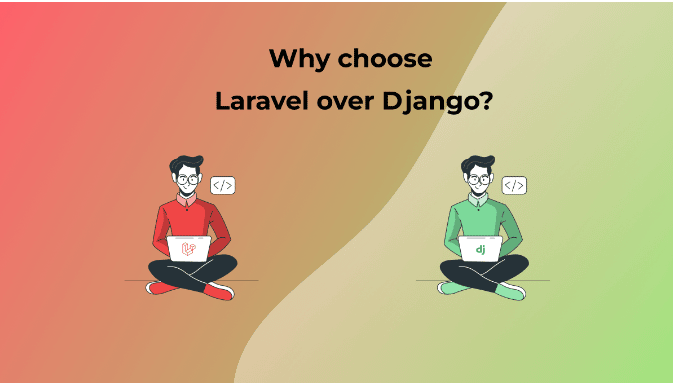Reasons on Why choose Laravel over Django?
Reasons on Why choose Laravel over Django?
One of the most important as well as difficult choices to make in web development is between web frameworks like Django and Laravel. A web framework functions as the “skeleton” on which you can build your web application, and it can make or destroy a project.
Laravel and Django are two of the most popular web frameworks. Both have great features, capabilities, and the ability to serve and exceed user requests across a range of industry verticals.
By contrasting Django vs Laravel based on different criteria, you may decide which is superior in this situation. To start, let’s clarify the fundamental ideas of web frameworks, followed by Django and Laravel.
Web frameworks
A web framework is an abstraction or a software framework that lacks complexity. They are employed in the creation and distribution of online applications. They are made up of sophisticated code and already written pre-built libraries. By adopting the framework, we may avoid having to learn complicated code and queries and the difficulty of creating low-level infrastructure.
Laravel
Laravel is an open-source framework written in PHP that manages server-side operations like HTML authentication, routing, templating, and many more.
It was created by Taylor Otwell and is built on Symfony, which gives users access to reusable PHP libraries and components. With the help of customized backend logic, a fully functional website may be created using Laravel. Laravel is used in some top-notch projects, like Rozerpay, Swat.io, 9GAG, Packet, and others. It has consequently become quite well-liked among developers.
Out of all the well-known web frameworks, Laravel has a 0.32 percent market share.
Django
Python-based Django is a well-known web framework. Adrian Holovaty and Simon Willison, two web programmers at the Lawrence Journal-World newspaper who were creating applications, were the ones who originally introduced this open-source, free framework. The project, which bears the name of the renowned guitarist Django Reinhardt, started development in 2003 and saw its first milestone release in September 2008.
Django has liberated the developers from tedious web development tasks, therefore there is no need to come up with solutions from scratch. Django also enables faster and more secure builds. It enables you to build entire apps because it has many pre-built features. It is compatible with all websites and supports a variety of formats (RSS feeds, HTML, XML, JSON, etc.). Django is also incredibly simple to scale and has a variety of security features.
Django runs 84,690 websites on 52,398 different domains.
Laravel vs Django
Code
The Django code may initially seem complicated. For the routing procedure, the regular expression is used, which is difficult for beginners. For improved routing services, you may also leverage third-party toolkits like Django Rest Framework.
Laravel’s code is readable and has been simplified. The routing code is clear and easy to understand. Laravel’s grouping functionality makes it possible to write code quickly for a large number of pages that have a common logic.
To restrict access to the pages to only authenticated users, the Laravel code for routes makes use of a group feature.
REST APIs for Django and Laravel
Application programming interfaces (APIs), a collection of definitions and protocols used in developing and integrating application software, are frequently used by application developers. By comprehending and executing the request, it facilitates interaction with a system to carry out a certain task or obtain information.
You can communicate with RESTful services via a RESTful API (also known as a REST API), which adheres to the REST architecture. In order for users to access resources or the web services they want, APIs serve as a common ground. Businesses can also utilize APIs to exchange data and resources while maintaining the necessary security, authentication, and control.
For each of these, you must select a web framework with superior RESTful API compatibility because you might not appreciate its fewer functionalities otherwise.
There is no built-in feature in Django that supports developing APIs. So, in order to access APIs with Django, you need a library.
Laravel, in contrast, has built-in API support. In Laravel, queries typically return JSON by default. Comparing Laravel to Django, here is where it excels: It’s clear, especially if you intend to build APIs that specifically cater to client needs.
Innovating Features
Laravel clearly has a benefit in terms of the functionality that each framework offers. Selecting the Laravel frameworks has so many advantages.
Laravel simplifies routing because it offers a simple API development process. The Object Relational Mapper (ORM) and high-level abstractions on relational databases allow developers to read, write, change, or erase database schemas and data using Python rather than SQL.
However, since Django has a built-in structure for creating an API, routing can be a little challenging. A REST framework is an option as well as creating one from scratch.
The Laravel website also provides in-house support and is somewhat speedier. Additional features include SASL support and caching backends.
Market Share and Popularity
React came in first place with 40.1 percent of the vote in a Statista survey to determine the most popular frameworks among developers in 2021. Django came in second with 15 percent and Laravel with 10.1 percent.
Django powers 57k+ distinct domains and 92k+ sites, to be exact. It is utilized by a variety of industries, including those in the arts, education, food and beverage, electronics and computer technology, and science and education. It is prevalent throughout the world, especially in nations like Canada, the US, the UK, India, China, Russia, Brazil, and others.
Conversely, Laravel supports more than 107k distinct domains and 146k websites online. It is well-liked across a variety of global industrial verticals, including law, government, science, education, and entertainment. The US, Japan, Russia, India, China, Brazil, etc. are the main users.
According to a survey by SimilarTech, despite its expansion and all the advantages we’ve seen it provide, Laravel outperforms Django in terms of market share. In the Top 10k, 100k, 1M, and the Entire Web categories, Laravel is leading the way internationally.
Django usage is being overtaken by Laravel across a number of industry sectors, such as computer electronics and technology, the arts and entertainment, banking, law and government, and business and consumer services.
When to choose Laravel?
If you are new to programming in PHP or do not feel ready, Laravel is the ideal choice. When developing any of the below, choose the Laravel Development Company to do it for you:
- A small-scale application or website similar to a blog
- Interactive site designs with compelling content
- Advanced apps with a tight budget
- CSS and JavaScript-based personalized web applications
- SEO-friendly software
- Projects in the fields of law, technology, entertainment, and the arts.
When to choose Django?
With Django, a high-level Python-based web framework, you can easily build web apps without the installation or dependency issues you typically encounter with other frameworks. For web development, Django should be used in the following circumstances:
- For creating a backend for an API or web application
- In order to develop certain web applications quickly
- Quick application deployment and scalability to meet your needs
- To create a secure single-page application for data publishing or data retrieval.
Conclusion
By taking into account all of the aforementioned criteria, choosing between Django and Laravel can be made simpler.
You can select any framework you prefer based on your needs because each has its own features and tools. Django might be a good option if you’re developing microservices with ML integration. Laravel is certainly a good choice if you’re creating dynamic, interactive websites that are easy to navigate and search engine friendly.
The option chosen is also influenced by the framework’s community support and developer availability. Django can be daunting for a novice. For beginners, Laravel is simple to use and offers more flexibility.






